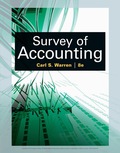
Concept explainers
Concept Introduction:
The fixed assets are of two types, one is tangible and other is intangible. The tangible assets are those which can be touched, i.e., having a physical presence. An asset which is used in the business for more than one year and is subject to
Depreciation is the expense which is debited to income statement against the cost of asset, i.e., cost of using the asset in the business or in other words, reduction in value due to wear, tear and obsolescence of the asset over its life.
The double-declining-balancing method is the method of computing the depreciation at the rate
The effects of using double-declining-balance depreciation instead of straight-line method on 'liquidity metrics free
Want to see the full answer?
Check out a sample textbook solution
Chapter 7 Solutions
Survey of Accounting (Accounting I)
- On March 1, 20X1, your company, which uses Units-of-Production (UOP) depreciation, purchases a machine for $300,000. You estimate the machine will have a useful life of 3,000,000 units and a residual value of $15,000. In 20X1, the machine produces 110,000 units; in 20X2, it produces 130,000 units. What is the balance in Accumulated Depreciation at the end of 20X2?arrow_forwardCan you explain this general accounting question using accurate calculation methods?arrow_forwardAccount Question answer wanted.arrow_forward
- Dylan Manufacturing had an estimated 90,000 direct labor hours, $360,000 manufacturing overhead, and 30,000 machine hours. The actual results were 91,200 direct labor hours, 32,500 machine hours, and $415,000 manufacturing overhead. Overhead is applied based on machine hours. Calculate the predetermined overhead rate. Helparrow_forwardAccounting problem and solutionarrow_forwardgeneral accountingarrow_forward
 Survey of Accounting (Accounting I)AccountingISBN:9781305961883Author:Carl WarrenPublisher:Cengage LearningPrinciples of Accounting Volume 1AccountingISBN:9781947172685Author:OpenStaxPublisher:OpenStax College
Survey of Accounting (Accounting I)AccountingISBN:9781305961883Author:Carl WarrenPublisher:Cengage LearningPrinciples of Accounting Volume 1AccountingISBN:9781947172685Author:OpenStaxPublisher:OpenStax College Cornerstones of Financial AccountingAccountingISBN:9781337690881Author:Jay Rich, Jeff JonesPublisher:Cengage Learning
Cornerstones of Financial AccountingAccountingISBN:9781337690881Author:Jay Rich, Jeff JonesPublisher:Cengage Learning


